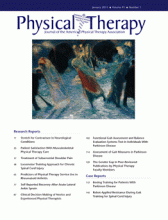Abstract
Background and Purpose The efficacy of task-specific gait training for people with spinal cord injury (SCI) is premised on evidence that the provision of gait-related afferent feedback is key for the recovery of stepping movements. Recent findings have shown that sensory feedback from flexor muscle afferents can facilitate flexor muscle activity during the swing phase of walking. This case report was undertaken to determine the feasibility of using robot-applied forces to resist leg movements during body-weight–supported treadmill training (BWSTT) and to measure its effect on gait and other health-related outcomes.
Case Description The patient described in this case report was a 43-year-old man with a T11 incomplete chronic SCI. He underwent 36 sessions of BWSTT using a robotic gait orthosis to provide forces that resist hip and knee flexion.
Outcomes Tolerance to the training program was monitored using the Borg CR10 scale and heart rate and blood pressure changes during each training session. Outcome measures (ie, 10-Meter Walk Test, Six-Minute Walk Test, modified Emory Functional Ambulation Profile [mEFAP], Activities-specific Balance Confidence Scale, and Canadian Occupational Performance Measure) were completed and kinematic parameters of gait, lower-extremity muscle strength (force-generating capacity), lower-limb girth, and tolerance to orthostatic stress were measured before and after the training program.
Discussion The patient could tolerate the training. Overground walking speed, endurance, and performance on all subtasks of the mEFAP improved and were accompanied by increased lower-limb joint flexion and toe clearance during gait. The patient's ambulatory self-confidence and self-perceived performance in walking also improved. These findings suggest that this new approach to BWSTT is a feasible and potentially effective therapy for improving skilled overground walking performance.
Footnotes
Dr Lam provided concept and idea. Dr Lam and Dr Eng provided project design. Dr Lam, Dr Krassioukov, and Dr Eng provided writing. Dr Lam, Ms Pauhl, and Dr Krassioukov provided data collection. Dr Lam and Dr Krassioukov provided data analysis. Dr Lam and Ms Pauhl provided project management. Dr Lam provided fund procurement, the patient, facilities/equipment, and institutional liaisons. Ms Pauhl provided consultation (including review of manuscript before submission). The authors are grateful to the patient for his commitment to this case report. The authors also thank Jennifer Loffree for her valuable assistance during this project.
This work was supported by the British Columbia Medical Services Foundation, with infrastructure support from the Canada Foundation for Innovation. The authors thank the Rick Hansen Wheels In Motion Event (Spinal Cord Injury-Solutions Network) for its financial support. Dr Lam was supported by a New Investigator Award from the Canadian Institutes of Health Research (MSH 95371). Dr Eng is a Senior Scholar with the Michael Smith Foundation for Health Research.
- Received January 18, 2010.
- Accepted September 20, 2010.












